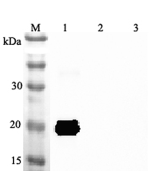Cookie Policy: This site uses cookies to improve your experience. You can find out more about our use of cookies in our Privacy Policy. By continuing to browse this site you agree to our use of cookies.
AdipoGen Life Sciences
IL-33 (mouse) (rec.) (His)

HEK-293 cells were transiently co-transfected with 500 ng of human ST2-containing vector (or empty vector as a negative control), a vector containing NF-κB-driven firefly luciferase, and a vector containing Renilla luciferase as a internal control in a 12-well plate. 40hr after transfection, cells were treated with IL33 (mouse) (rec.) (His) (Prod. No. AG-40A-0053) at the concentration as indicated for 8hr, followed by measurement with a dual luciferase assay.
| Product Details | |
|---|---|
| Synonyms | Interleukin-33; IL-1F11; NF-HEV |
| Product Type | Protein |
| Properties | |
| Source/Host | E. coli |
| Sequence | Mouse IL-33 (aa 109-266) is fused at the C-terminus to a His-tag. |
| Crossreactivity |
Human Mouse |
| Specificity | Binds to mouse and human ST2. |
| Biological Activity | Activates mouse and human ST2-dependent NF-κB pathway. |
| MW | ~20kDa (SDS-PAGE) |
| Purity | ≥90% (SDS-PAGE) |
| Endotoxin Content | <1EU/μg purified protein (LAL test; Lonza). |
| Formulation | Liquid. 0.2μm-filtered solution in 55mM TRIS-Cl, pH 8.2, containing 150mM NaCl. |
| Other Product Data | UniProt link Q2YEJ4: Interleukin-33 (mouse) |
| Shipping and Handling | |
| Shipping | BLUE ICE |
| Short Term Storage | +4°C |
| Long Term Storage | -20°C |
| Handling Advice |
After opening, prepare aliquots and store at -20°C. Avoid freeze/thaw cycles. For maximum product recovery after thawing, centrifuge the vial before opening the cap. |
| Use/Stability |
Stable for at least 2 years after receipt when stored at -20°C. Working aliquots are stable for up to 3 months when stored at -20°C. |
| Documents | |
| MSDS |
 Download PDF Download PDF |
| Product Specification Sheet | |
| Datasheet |
 Download PDF Download PDF |
Interleukin-33 (IL-33; HF-NEV; IL-1F11), a member of the IL-1 family of cytokines, is expressed by many cell types following pro-inflammatory stimulation and is thought to be released on cell lysis. The 30kDa human IL33 is converted by CASP1 to a 18kDa protein. IL33 binds to and signals through ST2 (IL1R1) and its stimulation recruits MYD88, IRAK, IRAK4, and TRAF6, followed by phosphorylation of ERK1 (MAPK3)/ERK2 (MAPK1), p38 (MAPK14), and JNK. The ability of IL-33 to target numerous immune cell types, like Th2-like cells, mast cells, and B1 cells, and to induce cytokine and chemokine production underlines its potential in influencing the outcome of a wide range of diseases, such as arthritis, asthma, atopic allergy & anaphylaxis, cardiovascular disease/atherosclerosis, nervous system diseases, and sepsis.








